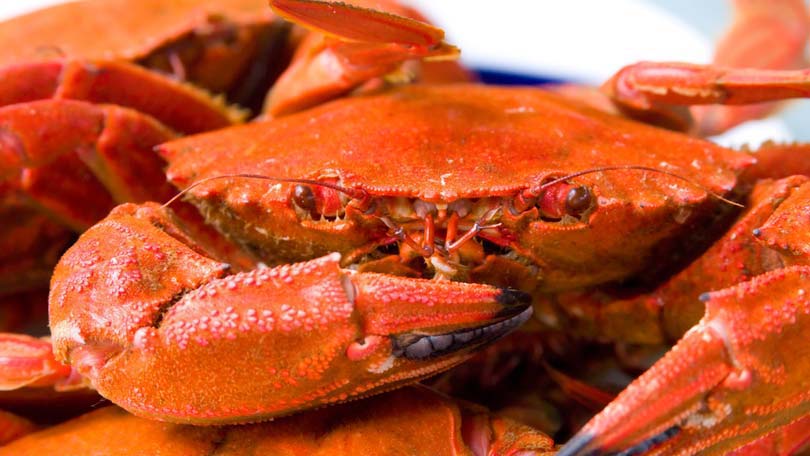
Learning how to cook crab is well worth the effort. High in minerals and protein, crab is a very healthy food to eat, and it’s low in calories. The nutrient composition of crab can always be found in the USDA database; however, you’ll find these specific nutrients in one Alaska King crab leg weighing 172 grams:
- 10 mg zinc which prevents fatigue and builds the immune system
- 1.6 mg copper which is important for healthy red blood cells
- 63 mcg selenium, which prevents cancer
- 377 mg phosphorus, which is essential for energy levels
- 32 grams protein, which keeps your body lean
- 144 calories
Crab also contains the carotenoids alpha and beta-carotene, lycopene, lutein, zeaxanthin, B-cryptoxanthin, very important phytonutrients important for eyesight, prostate health, and skin health.
What Do You Know about a Crab’s Shell?
Learning how to cook crab starts with crab selection. Crabs are like lobsters; they shed their shell when it’s time for them to grow bigger. In the process, the old shell is discarded and then the crab takes in a lot of water, thereby increasing its size. For a few days, the new shell is soft and then it begins to harden.
When buying crab, you can choose ones with a hard or soft shell. Chefs prefer the taste of soft shell crabs, which are more tender, more succulent and more flavorful.
In the U.S. and Canada, there are four primary types of crab: 1) Dungeness, large and meaty, 2) blue crab, good for frying, and 3) king crab, tender snowy white meat, and 4) snow crab, very tender snowy, white meat.
Select for Optimum Taste
If you’re purchasing live crabs, the taste will be better than with frozen crabs. Live crabs should not be in a fish tank for more than a week and should not smell like fish or ammonia. They should be lively, not just lie dormant in the tank. Crabs will stay fresh in the refrigerator for up to two days.
Some recipes call for either a male or female crab, so how do you determine which is which? It’s actually quite simple. The female has a triangle-shaped area on the underneath part of the shell.
Allow about 1-1/2 pounds crab per person when estimating exactly how much crab you will need. A 2-lb crab yields about 8 ounces crab meat.
Time to Cook Crab
When determining how to cook crab, your next step is the cooking pot selection. Your pot must be large enough to fit the crab’s 10 legs and have at least 3 inches of water covering the entire crab, legs and body both. You’ll also want to leave a few inches of clearance below the top rim. Fill the pot with water and add a few tablespoons salt for each half gallon water. The salty water mimics the seawater and keeps the natural sodium within the meat. Bring the water to a boil.
Next if you wish to be humane, you’ll probably ‘hypnotize’ the crab. This is similar to what you do to a lobster. Simply hold the crab by the legs, then stroke the top of its head. It will soon fall asleep. No need for lullabies. Then slowly drop it into the boiling water.
Cooking time starts when the water is boiling again. Allow about 15-20 minutes for a 2-lb crab and up to 10 minutes for smaller crabs. What you’re looking for is a bright orange-red color on the shell. No meat thermometers are needed.
Next immerse the crab into cold water for a few seconds and this will stop the cooking process immediately.
Serve crab with hot melted clarified butter and of course crab crackers and tiny forks to dig the meat out of the legs. The parts of the crab that are not eaten are the long, spongy gills, the triangular flap from the belly of the female and the reddish membrane that covers the center of the body.
And that’s all there is to learning how to cook crab. Will you be adding Alaskan king crab to your grocery list today?
